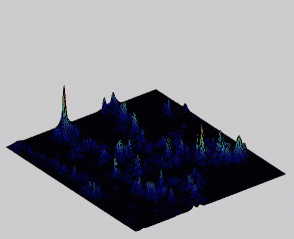Analysis of a Lizard Display with Varying Temporal Filters
In our laboratory, we work with small, arboreal lizards, such as these. To them birds are a potential predator, crickets are a potential prey while leaves and other vegetation are parts of the environment that would be beneficial to ignore. It is important to notice and respond to any moving birds, prey or the displays of other lizards, but to constantly respond to moving plants would be a problem. The previous examples, showing the effect of using different temporal delays, suggest that some filtering can take place on this level of processing.
This scene shows a small lizard make a short display, which consists of a rapid thrust of the body away from its branch, while vegetation is moving all around it.

The analysis with a short (T=1) and long (T=8) delay shows that the lizard to be more visible against the foreground and background vegetation with the short delay (T=1). This suggests a potential filtering strategy.
T=1 

T=8 


